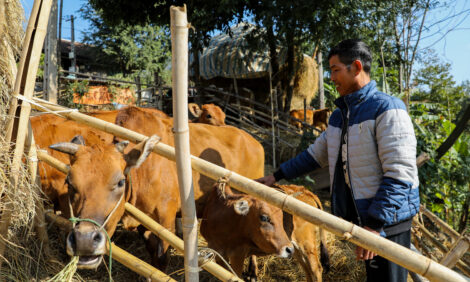



Wholecrop: A Potential Alternative Forage
If current forage stocks are still looking low after first and second cut, then take a serious look at wholecrop in the next few days, writes Advanced Nutrition’s Eoghan Mullery.Ensiled cereal wholecrop provides additional energy combined with fibre, it opens up the ration and helps create a healthy rumen environment which in turn can benefit intakes.
One of the advantages that wholecrop has over maize silage, particularly in Scotland, is the ability to grow a consistent crop every year, writes Mr Mullery.
Indeed wholecrop crops often supply more dry matter yields and starch content than maize.
If you already harvest wholecrop, then start to calculate how much extra you may need this season and if necessary investigate opportunities to buy standing crops where available.

*
"If ensiling wholecrop is not an option, then obtaining standing cereal fields to help bulk up current forage stocks is still worthwhile considering"
Eoghan Mullery, ruminant specialist at Adavanced Nutrition says that Scottish farmers can consistently grow wholecrop every year.
If you are scheduled to be a first time wholecrop user, then consider the potential benefits - it could be the saving grace.
However, before you make the decision, consider the following points:
- Can you effectively clamp and preserve wholecrop? Wholecrop is generally a much drier product than grass silage, and due to its physical nature needs good practice when pitting. It won’t roll as easily and extra weight on the pit is advised.
- Clamping - ideally ensile in a long narrow pit to make consolidating easier and crucially keep a narrow pit face when opened to prevent heating after exposure to air. If clamped in a wide pit, move across the clamp as quickly as possible; consider using a half shear grab block to help.
- Will the wholecrop be ensiled on top of grass silages? If so, then the wholecrop will need real attention to detail to ensure wastage is minimised. An additive is a must and wholecrop requires a crop specific additive so selection is key.
- At what stage to take the cut and ensile? This is an area that receives much attention every year - do I go cheesy or allow to mature and crack? My experience tells me that either way will give similar feeding results, and starch availability to the rumen is relatively similar in terms of what you get back. With dry first and second grass silage cuts being harvested, my preference is to harvest at the soft dough/cheddar stage and aim for 32 per cent to 40 per cent DM. Harvesting at this stage gives the most flexibility and is the lower risk option. At 35 per cent DM the crop should ensile nicely and I don’t generally see an issue for cows digesting the grain if in an effectively balanced diet. Drier wholecrop, which is known as alkaline, probably does offer the greater performance potential but is more difficult to get right and being much drier, carries a higher risk of heating after the pit is opened.
However, before you make the decision, consider the following points:
If ensiling wholecrop is not an option, then obtaining standing cereal fields to help bulk up current forage stocks is still worthwhile considering. Harvesting the grain at mature stage and then crimping or combining coupled with straw available for feeding will be an economical choice this coming year.
Silage stocks are tight throughout the country, so to avoid the scramble that we had this spring, investigating all current forage options available is crucial.



